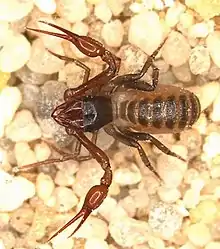Pseudotyrannochthoniidae
Pseudotyrannochthoniidae is a family of pseudoscorpions, belonging to the superfamily Chthonioidea. It represents the most basal and primitive group of living pseudoscorpions, with less than 100 species in 6 genera. Living members of the group have a strongly disjunct distribution, likely reflecting ancient vicariance, occurring in Australia, Asia, Southern Africa and Madagascar, Western North America and southern South America. Fossils species are known from the Eocene Baltic and Bitterfeld amber, which represent members of extant Asian genera.[1]
| Pseudotyrannochthoniidae Temporal range: | |
|---|---|
 | |
| Pseudotyrannochthonius giganteus from Western Australia | |
| Scientific classification | |
| Domain: | Eukaryota |
| Kingdom: | Animalia |
| Phylum: | Arthropoda |
| Subphylum: | Chelicerata |
| Class: | Arachnida |
| Order: | Pseudoscorpiones |
| Superfamily: | Chthonioidea |
| Family: | Pseudotyrannochthoniidae Beier, 1932 |
| Genera | |
|
See text | |
Taxonomy
- Afrochthonius Beier, 1930 South Africa, Madagascar and Sri Lanka
- Allochthonius Chamberlin, 1929 East Asia (Fossil species known from Baltic amber)
- Centrochthonius Beier, 1931 Central Asia (Fossil species known from Bitterfeld amber)
- Pseudotyrannochthonius Beier, 1930 from Chile, Australia, eastern Asia, and the western United States
- Selachochthonius Chamberlin, 1929 South Africa
- Spelaeochthonius Morikawa, 1954 East Asia
References
- Schwarze, Daniel; Harms, Danilo; Hammel, Jörg U.; Kotthoff, Ulrich (2021-06-22). "The first fossils of the most basal pseudoscorpion family (Arachnida: Pseudoscorpiones: Pseudotyrannochthoniidae): evidence for major biogeographical shifts in the European paleofauna". PalZ. doi:10.1007/s12542-021-00565-8. ISSN 1867-6812.
This article is issued from Wikipedia. The text is licensed under Creative Commons - Attribution - Sharealike. Additional terms may apply for the media files.